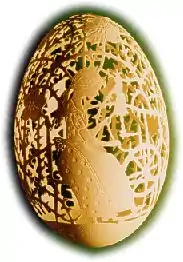复活节彩蛋
复活节彩蛋是西方国家在庆祝复活节时特别装饰性的蛋。传统上一般是使用经过染色的蛋类。现代的习惯通常是使用蛋状的巧克力代替。彩蛋一般事先藏好,然后由儿童来找寻。是復活节的象征性物品,是表达友谊、关爱和祝愿的方式。基督徒以復活蛋比喻為「新生命的開始」,象徵「耶穌復活、走出石墓」。

复活节蛋雕

塞尔维亚复活节彩蛋
用蛋來象徵生命的復活,在耶穌基督降生之前就已經很流行。西歐人士相信蛋是有兩次生命的,第一次是「新生」,第二次則是「重生」,重生就是象徵了復活的意思。
各个地区
在日耳曼文化地区(德意志地區、北欧和英語世界),复活节彩蛋通常和复活节兔一起出现。也有人认为复活节蛋是由复活节兔子带来的。
在法国和比利时,据说蛋是由天空中飞过的鐘扔下的。在基督教的传统中,教堂的钟会在复活节前一个周五保持沉默,为了纪念受难而死的基督,然后在复活节的早上重新敲响来纪念主的重生。教堂的钟,会带着翅膀,先飞向罗马,再在复活节的早上飞回来,途中洒落复活节的蛋。
參考資料
- Frank A. Salamone. . Berkshire Publishing Group. 2004 [7 April 2012]. (原始内容存档于2013-06-20).
The Easter egg predates the Christian celebration of Easter.
- Treasures from Royal Tombs of Ur By Richard L. Zettler, Lee Horne, Donald P. Hansen, Holly Pittman 1998 pgs 70-72
- . T.B. Noonan. 1881 [7 April 2012]. (原始内容存档于2014-01-03).
The early Christians of Mesopotamia had the custom of dyeing and decorating eggs at Easter. They were stained red, in memory of the blood of Christ, shed at His crucifixion. The Church adopted the custom, and regarded the eggs as the emblem of the resurrection, as is evinced by the benediction of Pope Paul V., about 1610, which reads thus: "Bless, O Lord! we beseech thee, this thy creature of eggs, that it may become a wholesome sustenance to thy faithful servants, eating it in thankfulness to thee on account of the resurrection of the Lord." Thus the custom has come down from ages lost in antiquity.)
This article is issued from Wikipedia. The text is licensed under Creative Commons - Attribution - Sharealike. Additional terms may apply for the media files.